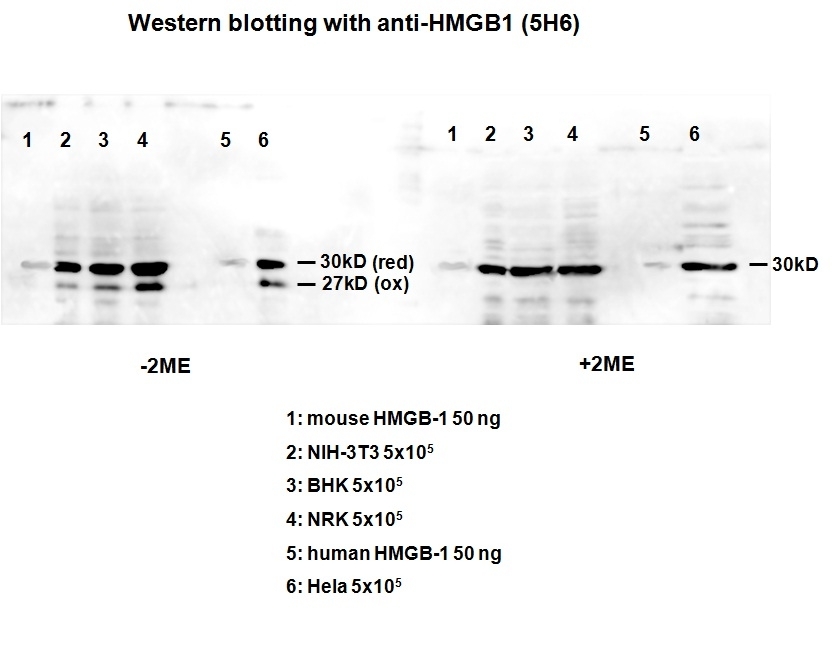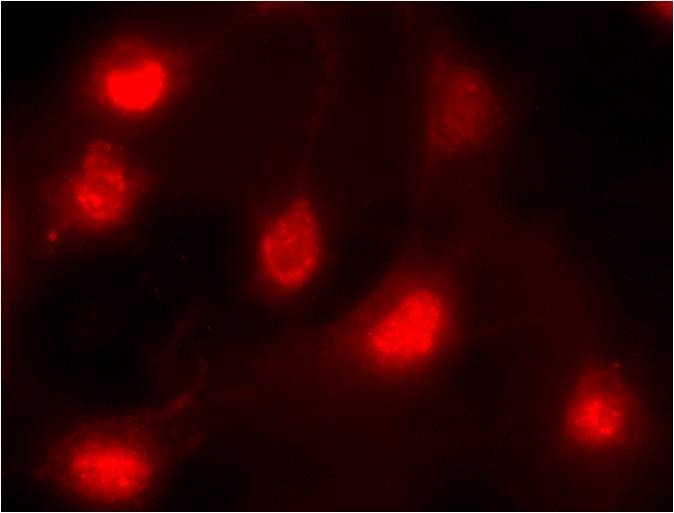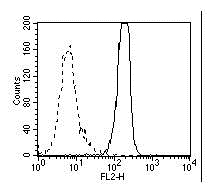High Mobility Group Protein B1 antibody | HMG1-5H6



Hamster anti High Mobility Group Protein B1
- Product Type
- Monoclonal Antibody
- Clone
- HMG1-5H6
- Isotype
- IgG
- Specificity
- High Mobility Group Protein B1
| Hamster anti High Mobility Group Protein B1 antibody, clone HMG1-5H6 recognizes high mobility group protein B1 (HMGB1), a ubiquitously expressed nuclear DNA binding protein belonging to the alarmin family. HMGB1 is released by necrotic and inflammatory cells acting as a chemoattractant for immature dendritic cells (DCs) and promoting their maturation. DCs can also secrete HMGB1, leading to proliferation and Th1 polarization of interacting T cells. HMGB1 is angiogenic and promotes cardiac stem cell growth and differentiation, it is a damage-associated molecular pattern molecule (DAMP) which co-precipitates with CD24. |
- Target Species
- Mouse
- Species Cross-Reactivity
-
Target Species Cross Reactivity Rat Human Hamster - N.B. Antibody reactivity and working conditions may vary between species.
- Product Form
- Purified IgG - liquid
- Preparation
- Purified IgG prepared by affinity chromatography on Protein G from tissue culture supernatant
- Buffer Solution
- Phosphate buffered saline
- Preservative Stabilisers
- <0.1% Sodium Azide (NaN3)
- Immunogen
- Recombinant mouse HMGB1.
- Approx. Protein Concentrations
- IgG concentration 1.0mg/ml
- Regulatory
- For research purposes only
- Guarantee
- 12 months from date of despatch
Avoid repeated freezing and thawing as this may denature the antibody. Storage in frost-free freezers is not recommended.
| Application Name | Verified | Min Dilution | Max Dilution |
|---|---|---|---|
| Flow Cytometry | |||
| Immunofluorescence | |||
| Western Blotting |
- Flow Cytometry
- Use 10ul of the suggested working dilution to label 1x106 cells in 100ul.
- Western Blotting
- MCA5765GA detects a band of approximately 30kDa in mouse NIH-3T3, rat NRK, hamster BHK, and HeLa cell lysates in the presence of 2ME, and bands of 30kDa (red) and 27kDa (ox) in the absence of 2ME.
| Description | Product Code | Applications | Pack Size | List Price | Your Price | Quantity | |
|---|---|---|---|---|---|---|---|
| Hamster (Armenian) IgG Negative Control | MCA2356 | F | 0.25 mg |
|
Log in | ||
| List Price | Your Price | ||||||
|
|
Log in | ||||||
| Description | Hamster (Armenian) IgG Negative Control | ||||||
Further Reading
-
Lange, S.S. et al (2009) HMGB1: the jack-of-all-trades protein is a master DNA repair mechanic.
Mol Carcinog. 48: 571-80.
- Synonyms
- HMGB1
- RRID
- AB_10844211
- UniProt
- P63158
- P63159
- P09429
- Entrez Gene
- HMGB1
- Hmgb1
- Hmgb1
- GO Terms
- GO:0000793 condensed chromosome
- GO:0001773 myeloid dendritic cell activation
- GO:0002407 dendritic cell chemotaxis
- GO:0002437 inflammatory response to antigenic stimulus
- GO:0003684 damaged DNA binding
- GO:0003690 double-stranded DNA binding
- GO:0003697 single-stranded DNA binding
- GO:0003700 sequence-specific DNA binding transcription factor activity
- GO:0005125 cytokine activity
- View More GO Terms
- GO:0005615 extracellular space
- GO:0005654 nucleoplasm
- GO:0005730 nucleolus
- GO:0006265 DNA topological change
- GO:0006288 base-excision repair, DNA ligation
- GO:0006309 DNA fragmentation involved in apoptotic nuclear change
- GO:0008301 DNA bending activity
- GO:0009986 cell surface
- GO:0017055 negative regulation of RNA polymerase II transcriptional preinitiation complex assembly
- GO:0031175 neuron projection development
- GO:0033151 V(D)J recombination
- GO:0042056 chemoattractant activity
- GO:0043065 positive regulation of apoptosis
- GO:0043280 positive regulation of caspase activity
- GO:0043388 positive regulation of DNA binding
- GO:0045087 innate immune response
- GO:0045944 positive regulation of transcription from RNA polymerase II promoter
- GO:0050786 RAGE receptor binding
- GO:0070491 repressing transcription factor binding
- GO:0001654 eye development
- GO:0003677 DNA binding
- GO:0005625 soluble fraction
- GO:0005634 nucleus
- GO:0005737 cytoplasm
- GO:0005694 chromosome
- GO:0008201 heparin binding
- GO:0010552 positive regulation of gene-specific transcription from RNA polymerase II promoter
- GO:0010858 calcium-dependent protein kinase regulator activity
- GO:0030295 protein kinase activator activity
- GO:0030324 lung development
- GO:0043005 neuron projection
- GO:0045639 positive regulation of myeloid cell differentiation
- GO:0045819 positive regulation of glycogen catabolic process
- GO:0051384 response to glucocorticoid stimulus
- GO:0000401 open form four-way junction DNA binding
- GO:0000402 crossed form four-way junction DNA binding
- GO:0000902 cell morphogenesis
- GO:0002053 positive regulation of mesenchymal cell proliferation
- GO:0003681 bent DNA binding
- GO:0050831 male-specific defense response to bacterium
- GO:0006935 chemotaxis
- GO:0007623 circadian rhythm
- GO:0008097 5S rRNA binding
- GO:0008134 transcription factor binding
- GO:0008156 negative regulation of DNA replication
- GO:0042493 response to drug
- GO:0009408 response to heat
- GO:0009749 response to glucose stimulus
- GO:0010976 positive regulation of neuron projection development
- GO:0014911 positive regulation of smooth muscle cell migration
- GO:0031532 actin cytoskeleton reorganization
- GO:0032392 DNA geometric change
- GO:0032496 response to lipopolysaccharide
- GO:0032868 response to insulin stimulus
- GO:0033034 positive regulation of myeloid cell apoptosis
- GO:0034341 response to interferon-gamma
- GO:0042277 peptide binding
- GO:0045663 positive regulation of myoblast differentiation
- GO:0045931 positive regulation of mitotic cell cycle
- GO:0046983 protein dimerization activity
- GO:0050727 regulation of inflammatory response
- GO:0050930 induction of positive chemotaxis
- GO:0051450 myoblast proliferation
- GO:0051861 glycolipid binding
- GO:0071347 cellular response to interleukin-1
MCA5765GA
If you cannot find the batch/lot you are looking for please contact our technical support team for assistance.
Please Note: All Products are "FOR RESEARCH PURPOSES ONLY"
View all Anti-Mouse ProductsAlways be the first to know.
When we launch new products and resources to help you achieve more in the lab.
Yes, sign me up

